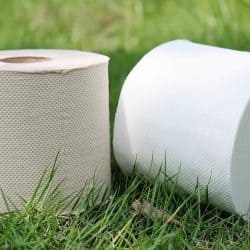It’s finally in your home kitchen. Well done! But wait… You aren’t done yet! To keep that new kitchen addition in tip-top shape, you’ve got to know what it takes. And that’s why I’m here. I’ll show you how to care for the bamboo cutting board – and it isn’t really complicated!
Bamboo is from grass and not wood. So, proper care is crucial in keeping it looking and working like new. After all, you want your board to stay in good condition so you can keep slicing and dicing away.
Here, expect some helpful information on keeping your board in the best condition. I’ll also cover the importance, common mistakes in care, and so much more in that line. So, if that’s what you are looking for, it must be your lucky day! But, of course, first things first!
JUMP TO: Why Bamboo is good for Cutting Board | How to Care For Cutting Board | Importance of Maintaining Cutting Board | Things to Avoid When Caring | When to Replace Cutting Board |
- Proper maintenance involves regularly cleaning, flattening, conditioning, disinfecting, and regularly deodorizing your bamboo cutting board.
- Avoid putting the board in the dishwasher, soaking it in water, using harsh chemicals on its surface, and applying natural cooking oils.
- Replace your board when it shows signs of cracks, splits, or heavy stains that won’t go away.
Is Bamboo Good For Cutting Boards?
Yes, Bamboo is suitable for wooden cutting boards. This cutting board has all the basic features of an ideal cutting board. It’s non-toxic, durable, sustainable, and antibacterial. As such, it’s an excellent option for commercial and home kitchens alike.
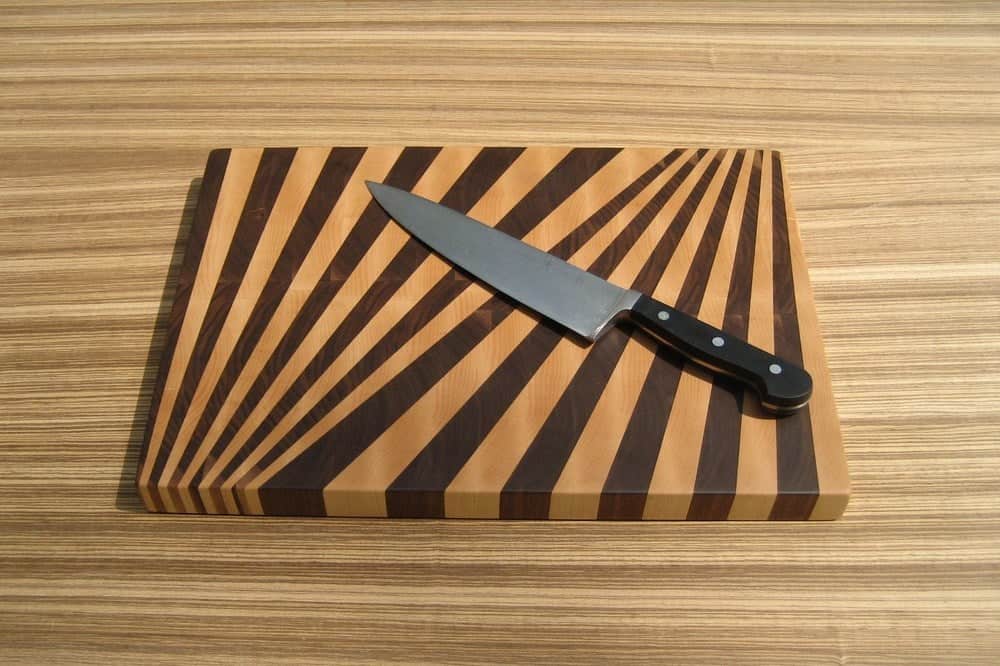
Source: www.monsoonempress.com
Before I dive deeper into the topic, you could have stumbled upon these comments on forums that present Bamboo as a bad choice for wooden cutting boards.
Well, don’t let that make you regret your purchase. Most of these comments are based on personal experiences or incorrect information.
The U.S. Department of Agriculture (USDA) rates Bamboo better for chopping boards than some woods. They even recommend this bamboo cutting board for both commercial and home use. I guess that should be enough to boost your confidence about your new purchase.
But generally and without sounding salesy, Bamboo has all the basic features of a great cutting board – from hardness to antibacterial properties. I’m here to prove that. Let’s look at the Pros and Cons of this material.
Pros Of Bamboo Cutting Boards
- Non-toxic: You don’t have to worry about any chemicals leaching into your food.
- Durability: Bamboo won’t warp, splinter, or crack easily.
- Sustainability: As the fastest-growing plant on the planet, Bamboo is renewable. Also, it’s easy to harvest without damaging its environment.
- Antibacterial: The surface of the board is resistant to bacteria and fungi growth
- Affordable: Compared to most hardwoods, Bamboo is relatively inexpensive.
- Aesthetic Appeal: Bamboo also has a beautiful, warm look that can enhance your kitchen’s decor.
Cons Of Bamboo Cutting Boards
- Silica content: Bamboo contains a naturally high level of silica. That’s not the best news for the edge.
- Material density: It’s too hard and may damage knives, especially those of cheap quality.
- Porous: While not as non-porous as some hardwoods, Bamboo is still porous.
As you can see, there are both pros and cons. But if you take proper care of your bamboo cutting board, it can last for years with minimal maintenance!
Let’s look at the steps you can take to care of your new bamboo cutting board.
Related Read: Acacia Vs. Bamboo Cutting Board [7 Differences Explained]
Bamboo Cutting Board Maintenance
Proper bamboo cutting board care is key to preserving the longevity of your board. Here are some of the steps you should take:
Conditioning
I know you can’t wait to chop and dice on your new board. But before that, oil it for proper conditioning.
Oiling before using your cutting board moisturizes it and enhances its water-proofing properties. Plus, conditioning keeps the board from splitting once you start using it. So, it’s a step you shouldn’t skip.
And when conditioning, stick to food-grade mineral oil. Other options, like vegetable, olive, and avocado oil, could do great. But they grow rancid with time, which could leave your chopping board smelling bad. So, work with mineral oil instead.
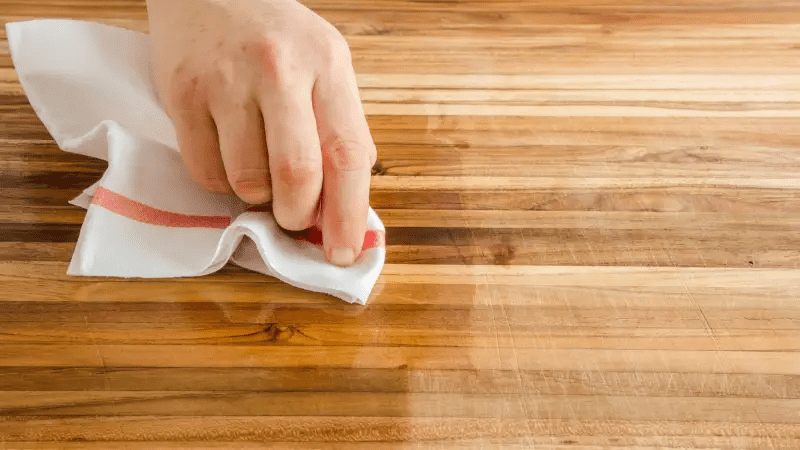
Source: America’s Test Kitchen
Don’t have food-grade mineral oil?
Don’t worry! Beeswax, Carnauba, and fractionated coconut oil are all suitable alternatives to bamboo cutting board oil. But if you can, get food-grade mineral oil.
Once you have the mineral oil, rub it into the board with a cloth. Repeat the procedure every day for a week and thereafter do it monthly.
Cleaning
Other than conditioning, your chopping board needs cleaning. Bamboo is a porous material that can allow bacteria to get in. To prevent this, spare a few minutes to clean your cutting board after each use.
Thankfully, you don’t need any commercial products for this. With a few standard household products, the rest should be a breeze.
Procedure:
- Rinse any food residue with water
- Sprinkle baking soda on any stains and let sit for 5 minutes
- Using a microfiber cloth, remove any food residues
- Quickly hand-wash in a solution containing warm water and dish soap
- Rinse with warm water
- Use a towel to soak up any excess moisture
- Store it upright and away from direct sun for it to air-dry
Of course, if your board doesn’t have stubborn stains, you don’t have to go through the whole process. Just pick up the procedure from washing with warm water and dish soap!
Also Read: Can You Stain Cutting Boards? [Methods+Stain Alternatives]
Flattening
All porous chopping boards slowly absorb moisture every time you wash them. That often causes the cutting board to curl or bend out of shape.
When you notice that you don’t need to get a new one for your bamboo cutting boards, warping is normal and happens to almost all porous boards.
You can flatten your cutting board back to shape with a few steps. And it’s a pretty straightforward process.
Procedure:
- Soak the cutting board in water for hours to make it pliable.
- Remove it and place it between two pieces of plywood. Ensure that the corners face down.
- Place some weight on the top until it dries.
- Alternatively, you can clamp the cutting board between two wood pieces and leave it overnight.
- Your cutting board should be back in shape the next morning.
Disinfecting
Bamboo is naturally antibacterial. But still, you may need to disinfect it from time to time. That’s especially important if you use the cutting board to cut chicken and other meat products.
For this, you don’t need any fancy cleaning product or disinfectant.
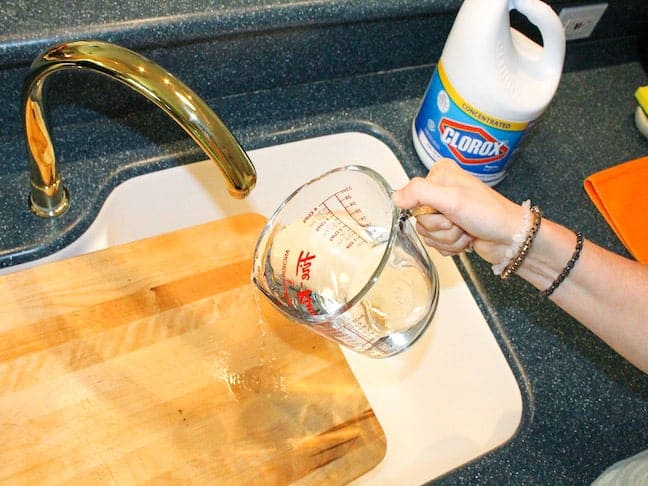
Source: momtastic.com
Procedure:
- Clean the cutting board using warm soapy water
- Using a cloth, rub the surface with white vinegar
- Rinse with warm water before the substance dries on the surface
- Use a paper towel to pat dry it before leaving it to air dry
Deodorizing
You use your cutting board for a plethora of recipes. So, sometimes it makes sense to want to deodorize it from any smell.
Don’t worry; the process is simple. All you need is lemon juice and some coarse salt.
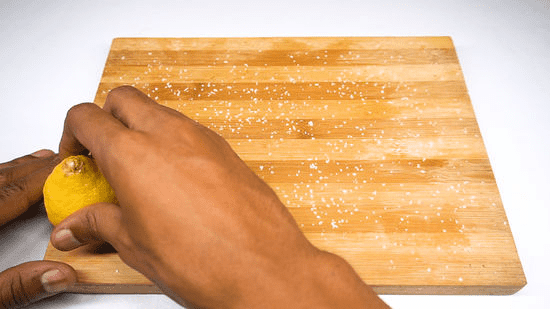
Source: wikiHow
Procedure:
- Generously spread salt on the piece
- Cut a lemon into two halves and use one half to rub the salt against the board. Switch to the other half if the first seems to no longer be effective.
- Do that until you’ve covered the entire piece
- Rinse with warm water
- Dry the cutting board immediately to keep it from absorbing water
With these steps, you should be able to keep your bamboo cutting board in its best shape. A few minutes of maintenance should make all the difference!
Importance Of Maintaining Your Bamboo Cutting Board
The benefits of maintaining your bamboo cutting board are numerous.
Here are a few of them:
Prevents Cross-Contamination
Cross-contamination happens when you put ready-to-eat foods on the same board you’d used for raw meat, fish, or other foods likely to contain bacteria.
But by regularly cleaning your board, you prevent the spread of any dangerous microbes and keep your family safe from foodborne illnesses.
Maintains The Beauty Of The Board
I bet beauty is one of the reasons you bought a bamboo cutting board in the first place. With proper maintenance, it will remain beautiful for years to come. The best way to do that is to follow the steps above; each of them will help you keep your board looking pristine.
Prolong Durability
Regular cleaning and maintenance will also help you extend the life of your board. Bamboo is a durable material, but it can weaken from exposure to water or other substances left on the surface for too long.
Avoid Cracks
Improper care can make your bamboo cutting board start cracking due to water or other substances. Apparently, that’s not something you want to happen. Proper cleaning and maintenance are the best ways to avoid such.
Things To Avoid When Caring For Bamboo Cutting Boards
Though there are plenty of ways to care for your board, it’s also essential to know what to avoid. Here are a few of them:
Putting In Dishwasher
It can be tempting, but never put your board in the dishwasher. The intense heat and water pressure will weaken it, making it susceptible to cracking or splitting.
Soaking In Water
It’s a bad idea to soak bamboo cutting boards for an extended period of time. The material can absorb water, weakening the board and making it prone to cracking or splitting.
Using Harsh Chemicals
You should avoid using harsh chemicals like rubbing alcohol on your board. Thankfully, the maintenance steps don’t require you to do so. In fact, the most effective cleaning method is using warm water and soap or vinegar.
Using Natural Cooking Oils
While natural cooking oils can help condition the board and make it look shiny, they aren’t the best for your chopping board maintenance. These oils experience rancidification, which can give off an unpleasant smell.
When Replacement Is Necessary
Knowing when to replace your bamboo cutting board piece is as important as knowing its maintenance.
A few tell-tale signs of replacement are:
- Grooves that make the board hard to clean effectively
- Heavy stains that won’t go away no matter how hard you try
- Signs of cracking or splitting
Those are all indications that replacement needs to happen. Now, you can get a new board and take all the necessary steps to maintain it properly.
Conclusion
Caring for a bamboo cutting board is easy. With a few steps, you can keep the cutting board looking new and ensure it stays safe for use. Avoid putting it in the dishwasher, soaking it in water, using harsh chemicals on its surface, and applying natural cooking oils. Also, look out for signs of replacement and get a new one where necessary.
![Bamboo Vs. Wood Cutting Board [9 Differences Explained] Bamboo Vs. Wood Cutting Board [9 Differences Explained]](https://houseadorable.com/wp-content/uploads/2023/01/cutting-board.jpg)
![Is Bamboo Wood Good for Cutting Boards?[8 Reasons Explained] Is Bamboo Wood Good for Cutting Boards?[8 Reasons Explained]](https://houseadorable.com/wp-content/uploads/2023/01/316002766_5887666997938019_9068589372518329358_n.jpg)
![Wood Cutting Board Vs. Plastic Board [Which is Safer?] Wood Cutting Board Vs. Plastic Board [Which is Safer?]](https://houseadorable.com/wp-content/uploads/2023/01/wood-board.jpg)
![Is Acacia Wood Good For Cutting Boards? [Explained] Is Acacia Wood Good For Cutting Boards? [Explained]](https://houseadorable.com/wp-content/uploads/2023/01/wood-table-top-with-acacia-chopping-board-with-blur-kitchen-counter-background-is.jpg)
![27 Types of Cutting Boards Explained [Buying Guide Included] 27 Types of Cutting Boards Explained [Buying Guide Included]](https://houseadorable.com/wp-content/uploads/2022/12/cutting-board.jpg)
![Acacia Vs. Bamboo Cutting Board [7 Differences Explained] Acacia Vs. Bamboo Cutting Board [7 Differences Explained]](https://houseadorable.com/wp-content/uploads/2022/12/fetured.jpg)
![Charcuterie Board Vs. Cutting Board [8 Differences] Charcuterie Board Vs. Cutting Board [8 Differences]](https://houseadorable.com/wp-content/uploads/2023/01/316322082_5650827684977137_862859335334204275_n.jpg)
